Loss and Grief Theory Application: A Case Study of Tina and Graham
VerifiedAdded on 2023/06/16
|9
|2966
|71
Case Study
AI Summary
This case study examines the application of loss and grief theories, including Freud's model of bereavement, Kubler-Ross grief cycle, and Bowlby's attachment theory, to the case of Tina and Graham, who experienced the loss of their newborn child. The analysis focuses on the emotional and mental impacts of grief, particularly on Tina, and explores potential interventions by social workers and family members to facilitate healing and acceptance. The study highlights the importance of addressing emotional pain, promoting social engagement, and understanding the stages of grief to support individuals through the bereavement process. The role of social workers in assessing grief symptoms and implementing appropriate strategies is also emphasized.
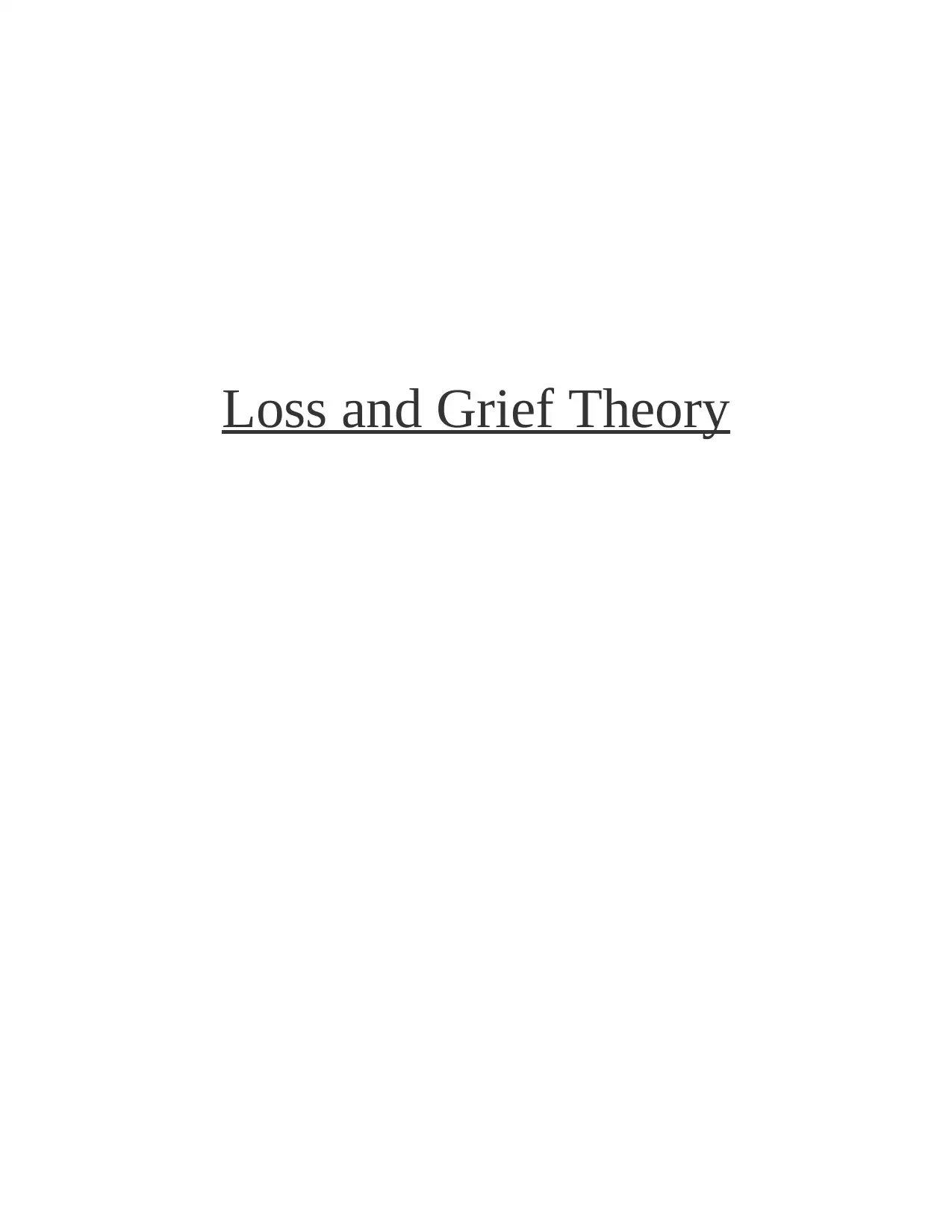
Loss and Grief Theory
Paraphrase This Document
Need a fresh take? Get an instant paraphrase of this document with our AI Paraphraser

TABLE OF CONTENT
INTRODUCTION...........................................................................................................................3
MAIN BODY..................................................................................................................................3
Loss and grief in Tina and Graham case.....................................................................................3
CONCLUSION................................................................................................................................8
REFERENCES................................................................................................................................1
INTRODUCTION...........................................................................................................................3
MAIN BODY..................................................................................................................................3
Loss and grief in Tina and Graham case.....................................................................................3
CONCLUSION................................................................................................................................8
REFERENCES................................................................................................................................1
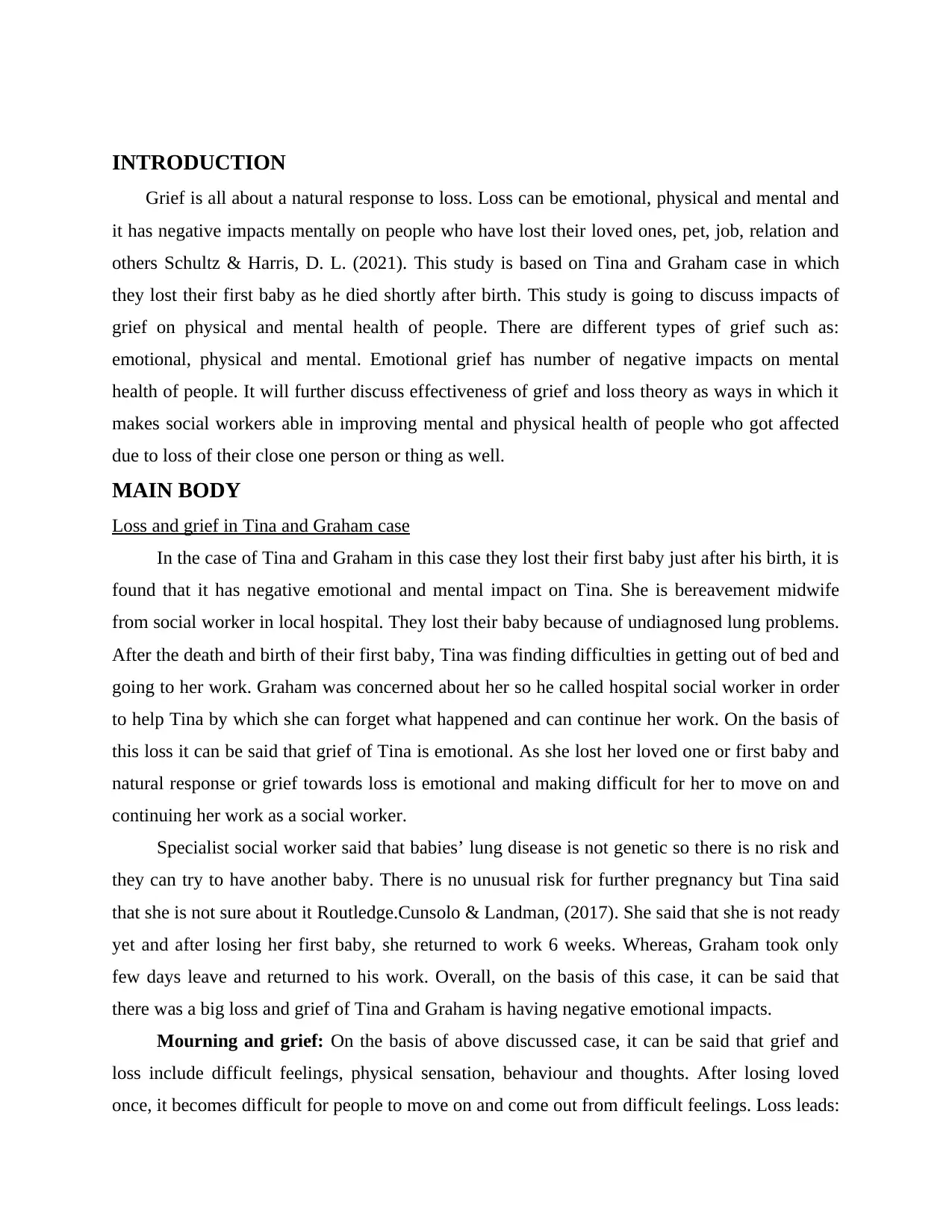
INTRODUCTION
Grief is all about a natural response to loss. Loss can be emotional, physical and mental and
it has negative impacts mentally on people who have lost their loved ones, pet, job, relation and
others Schultz & Harris, D. L. (2021). This study is based on Tina and Graham case in which
they lost their first baby as he died shortly after birth. This study is going to discuss impacts of
grief on physical and mental health of people. There are different types of grief such as:
emotional, physical and mental. Emotional grief has number of negative impacts on mental
health of people. It will further discuss effectiveness of grief and loss theory as ways in which it
makes social workers able in improving mental and physical health of people who got affected
due to loss of their close one person or thing as well.
MAIN BODY
Loss and grief in Tina and Graham case
In the case of Tina and Graham in this case they lost their first baby just after his birth, it is
found that it has negative emotional and mental impact on Tina. She is bereavement midwife
from social worker in local hospital. They lost their baby because of undiagnosed lung problems.
After the death and birth of their first baby, Tina was finding difficulties in getting out of bed and
going to her work. Graham was concerned about her so he called hospital social worker in order
to help Tina by which she can forget what happened and can continue her work. On the basis of
this loss it can be said that grief of Tina is emotional. As she lost her loved one or first baby and
natural response or grief towards loss is emotional and making difficult for her to move on and
continuing her work as a social worker.
Specialist social worker said that babies’ lung disease is not genetic so there is no risk and
they can try to have another baby. There is no unusual risk for further pregnancy but Tina said
that she is not sure about it Routledge.Cunsolo & Landman, (2017). She said that she is not ready
yet and after losing her first baby, she returned to work 6 weeks. Whereas, Graham took only
few days leave and returned to his work. Overall, on the basis of this case, it can be said that
there was a big loss and grief of Tina and Graham is having negative emotional impacts.
Mourning and grief: On the basis of above discussed case, it can be said that grief and
loss include difficult feelings, physical sensation, behaviour and thoughts. After losing loved
once, it becomes difficult for people to move on and come out from difficult feelings. Loss leads:
Grief is all about a natural response to loss. Loss can be emotional, physical and mental and
it has negative impacts mentally on people who have lost their loved ones, pet, job, relation and
others Schultz & Harris, D. L. (2021). This study is based on Tina and Graham case in which
they lost their first baby as he died shortly after birth. This study is going to discuss impacts of
grief on physical and mental health of people. There are different types of grief such as:
emotional, physical and mental. Emotional grief has number of negative impacts on mental
health of people. It will further discuss effectiveness of grief and loss theory as ways in which it
makes social workers able in improving mental and physical health of people who got affected
due to loss of their close one person or thing as well.
MAIN BODY
Loss and grief in Tina and Graham case
In the case of Tina and Graham in this case they lost their first baby just after his birth, it is
found that it has negative emotional and mental impact on Tina. She is bereavement midwife
from social worker in local hospital. They lost their baby because of undiagnosed lung problems.
After the death and birth of their first baby, Tina was finding difficulties in getting out of bed and
going to her work. Graham was concerned about her so he called hospital social worker in order
to help Tina by which she can forget what happened and can continue her work. On the basis of
this loss it can be said that grief of Tina is emotional. As she lost her loved one or first baby and
natural response or grief towards loss is emotional and making difficult for her to move on and
continuing her work as a social worker.
Specialist social worker said that babies’ lung disease is not genetic so there is no risk and
they can try to have another baby. There is no unusual risk for further pregnancy but Tina said
that she is not sure about it Routledge.Cunsolo & Landman, (2017). She said that she is not ready
yet and after losing her first baby, she returned to work 6 weeks. Whereas, Graham took only
few days leave and returned to his work. Overall, on the basis of this case, it can be said that
there was a big loss and grief of Tina and Graham is having negative emotional impacts.
Mourning and grief: On the basis of above discussed case, it can be said that grief and
loss include difficult feelings, physical sensation, behaviour and thoughts. After losing loved
once, it becomes difficult for people to move on and come out from difficult feelings. Loss leads:
You're viewing a preview
Unlock full access by subscribing today!
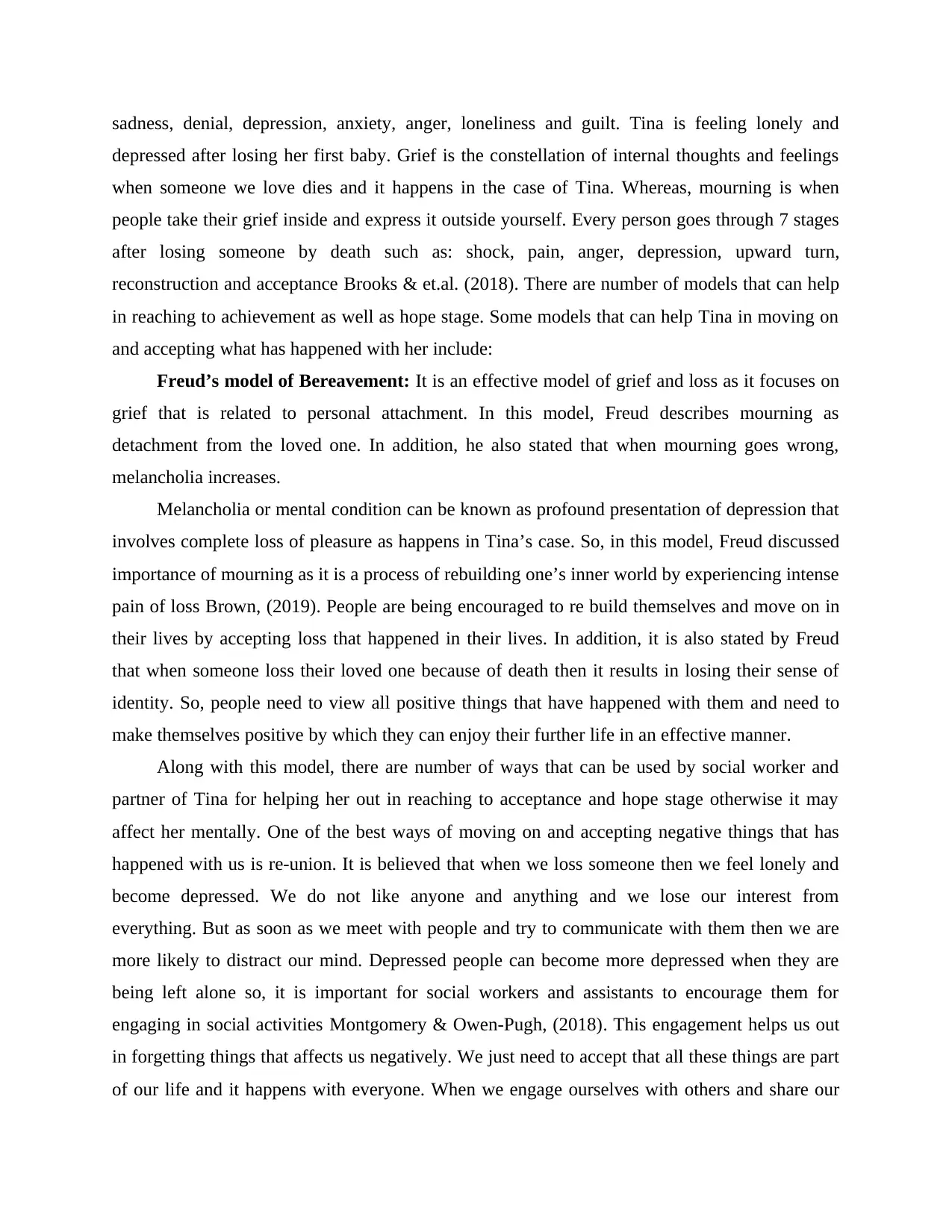
sadness, denial, depression, anxiety, anger, loneliness and guilt. Tina is feeling lonely and
depressed after losing her first baby. Grief is the constellation of internal thoughts and feelings
when someone we love dies and it happens in the case of Tina. Whereas, mourning is when
people take their grief inside and express it outside yourself. Every person goes through 7 stages
after losing someone by death such as: shock, pain, anger, depression, upward turn,
reconstruction and acceptance Brooks & et.al. (2018). There are number of models that can help
in reaching to achievement as well as hope stage. Some models that can help Tina in moving on
and accepting what has happened with her include:
Freud’s model of Bereavement: It is an effective model of grief and loss as it focuses on
grief that is related to personal attachment. In this model, Freud describes mourning as
detachment from the loved one. In addition, he also stated that when mourning goes wrong,
melancholia increases.
Melancholia or mental condition can be known as profound presentation of depression that
involves complete loss of pleasure as happens in Tina’s case. So, in this model, Freud discussed
importance of mourning as it is a process of rebuilding one’s inner world by experiencing intense
pain of loss Brown, (2019). People are being encouraged to re build themselves and move on in
their lives by accepting loss that happened in their lives. In addition, it is also stated by Freud
that when someone loss their loved one because of death then it results in losing their sense of
identity. So, people need to view all positive things that have happened with them and need to
make themselves positive by which they can enjoy their further life in an effective manner.
Along with this model, there are number of ways that can be used by social worker and
partner of Tina for helping her out in reaching to acceptance and hope stage otherwise it may
affect her mentally. One of the best ways of moving on and accepting negative things that has
happened with us is re-union. It is believed that when we loss someone then we feel lonely and
become depressed. We do not like anyone and anything and we lose our interest from
everything. But as soon as we meet with people and try to communicate with them then we are
more likely to distract our mind. Depressed people can become more depressed when they are
being left alone so, it is important for social workers and assistants to encourage them for
engaging in social activities Montgomery & Owen-Pugh, (2018). This engagement helps us out
in forgetting things that affects us negatively. We just need to accept that all these things are part
of our life and it happens with everyone. When we engage ourselves with others and share our
depressed after losing her first baby. Grief is the constellation of internal thoughts and feelings
when someone we love dies and it happens in the case of Tina. Whereas, mourning is when
people take their grief inside and express it outside yourself. Every person goes through 7 stages
after losing someone by death such as: shock, pain, anger, depression, upward turn,
reconstruction and acceptance Brooks & et.al. (2018). There are number of models that can help
in reaching to achievement as well as hope stage. Some models that can help Tina in moving on
and accepting what has happened with her include:
Freud’s model of Bereavement: It is an effective model of grief and loss as it focuses on
grief that is related to personal attachment. In this model, Freud describes mourning as
detachment from the loved one. In addition, he also stated that when mourning goes wrong,
melancholia increases.
Melancholia or mental condition can be known as profound presentation of depression that
involves complete loss of pleasure as happens in Tina’s case. So, in this model, Freud discussed
importance of mourning as it is a process of rebuilding one’s inner world by experiencing intense
pain of loss Brown, (2019). People are being encouraged to re build themselves and move on in
their lives by accepting loss that happened in their lives. In addition, it is also stated by Freud
that when someone loss their loved one because of death then it results in losing their sense of
identity. So, people need to view all positive things that have happened with them and need to
make themselves positive by which they can enjoy their further life in an effective manner.
Along with this model, there are number of ways that can be used by social worker and
partner of Tina for helping her out in reaching to acceptance and hope stage otherwise it may
affect her mentally. One of the best ways of moving on and accepting negative things that has
happened with us is re-union. It is believed that when we loss someone then we feel lonely and
become depressed. We do not like anyone and anything and we lose our interest from
everything. But as soon as we meet with people and try to communicate with them then we are
more likely to distract our mind. Depressed people can become more depressed when they are
being left alone so, it is important for social workers and assistants to encourage them for
engaging in social activities Montgomery & Owen-Pugh, (2018). This engagement helps us out
in forgetting things that affects us negatively. We just need to accept that all these things are part
of our life and it happens with everyone. When we engage ourselves with others and share our
Paraphrase This Document
Need a fresh take? Get an instant paraphrase of this document with our AI Paraphraser
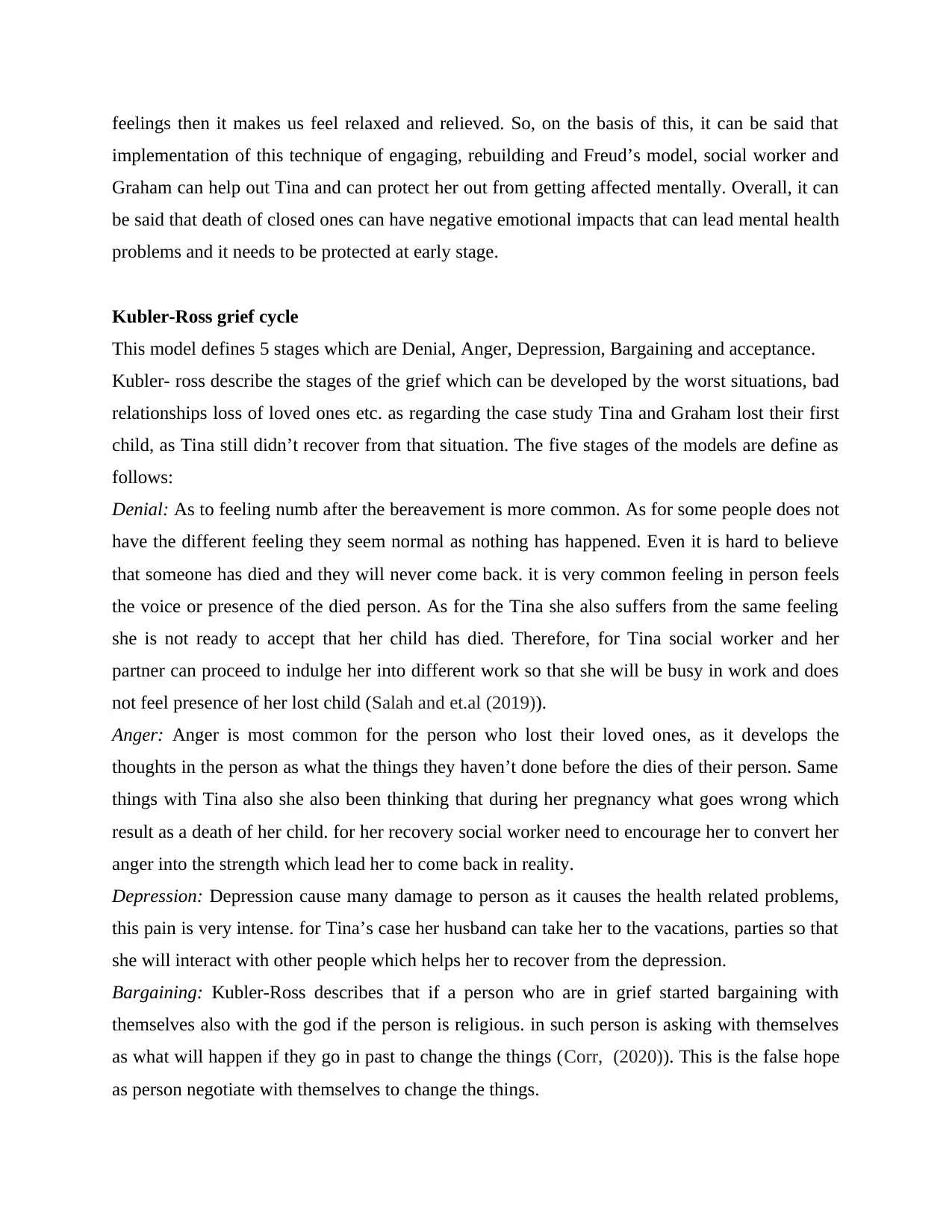
feelings then it makes us feel relaxed and relieved. So, on the basis of this, it can be said that
implementation of this technique of engaging, rebuilding and Freud’s model, social worker and
Graham can help out Tina and can protect her out from getting affected mentally. Overall, it can
be said that death of closed ones can have negative emotional impacts that can lead mental health
problems and it needs to be protected at early stage.
Kubler-Ross grief cycle
This model defines 5 stages which are Denial, Anger, Depression, Bargaining and acceptance.
Kubler- ross describe the stages of the grief which can be developed by the worst situations, bad
relationships loss of loved ones etc. as regarding the case study Tina and Graham lost their first
child, as Tina still didn’t recover from that situation. The five stages of the models are define as
follows:
Denial: As to feeling numb after the bereavement is more common. As for some people does not
have the different feeling they seem normal as nothing has happened. Even it is hard to believe
that someone has died and they will never come back. it is very common feeling in person feels
the voice or presence of the died person. As for the Tina she also suffers from the same feeling
she is not ready to accept that her child has died. Therefore, for Tina social worker and her
partner can proceed to indulge her into different work so that she will be busy in work and does
not feel presence of her lost child (Salah and et.al (2019)).
Anger: Anger is most common for the person who lost their loved ones, as it develops the
thoughts in the person as what the things they haven’t done before the dies of their person. Same
things with Tina also she also been thinking that during her pregnancy what goes wrong which
result as a death of her child. for her recovery social worker need to encourage her to convert her
anger into the strength which lead her to come back in reality.
Depression: Depression cause many damage to person as it causes the health related problems,
this pain is very intense. for Tina’s case her husband can take her to the vacations, parties so that
she will interact with other people which helps her to recover from the depression.
Bargaining: Kubler-Ross describes that if a person who are in grief started bargaining with
themselves also with the god if the person is religious. in such person is asking with themselves
as what will happen if they go in past to change the things (Corr, (2020)). This is the false hope
as person negotiate with themselves to change the things.
implementation of this technique of engaging, rebuilding and Freud’s model, social worker and
Graham can help out Tina and can protect her out from getting affected mentally. Overall, it can
be said that death of closed ones can have negative emotional impacts that can lead mental health
problems and it needs to be protected at early stage.
Kubler-Ross grief cycle
This model defines 5 stages which are Denial, Anger, Depression, Bargaining and acceptance.
Kubler- ross describe the stages of the grief which can be developed by the worst situations, bad
relationships loss of loved ones etc. as regarding the case study Tina and Graham lost their first
child, as Tina still didn’t recover from that situation. The five stages of the models are define as
follows:
Denial: As to feeling numb after the bereavement is more common. As for some people does not
have the different feeling they seem normal as nothing has happened. Even it is hard to believe
that someone has died and they will never come back. it is very common feeling in person feels
the voice or presence of the died person. As for the Tina she also suffers from the same feeling
she is not ready to accept that her child has died. Therefore, for Tina social worker and her
partner can proceed to indulge her into different work so that she will be busy in work and does
not feel presence of her lost child (Salah and et.al (2019)).
Anger: Anger is most common for the person who lost their loved ones, as it develops the
thoughts in the person as what the things they haven’t done before the dies of their person. Same
things with Tina also she also been thinking that during her pregnancy what goes wrong which
result as a death of her child. for her recovery social worker need to encourage her to convert her
anger into the strength which lead her to come back in reality.
Depression: Depression cause many damage to person as it causes the health related problems,
this pain is very intense. for Tina’s case her husband can take her to the vacations, parties so that
she will interact with other people which helps her to recover from the depression.
Bargaining: Kubler-Ross describes that if a person who are in grief started bargaining with
themselves also with the god if the person is religious. in such person is asking with themselves
as what will happen if they go in past to change the things (Corr, (2020)). This is the false hope
as person negotiate with themselves to change the things.
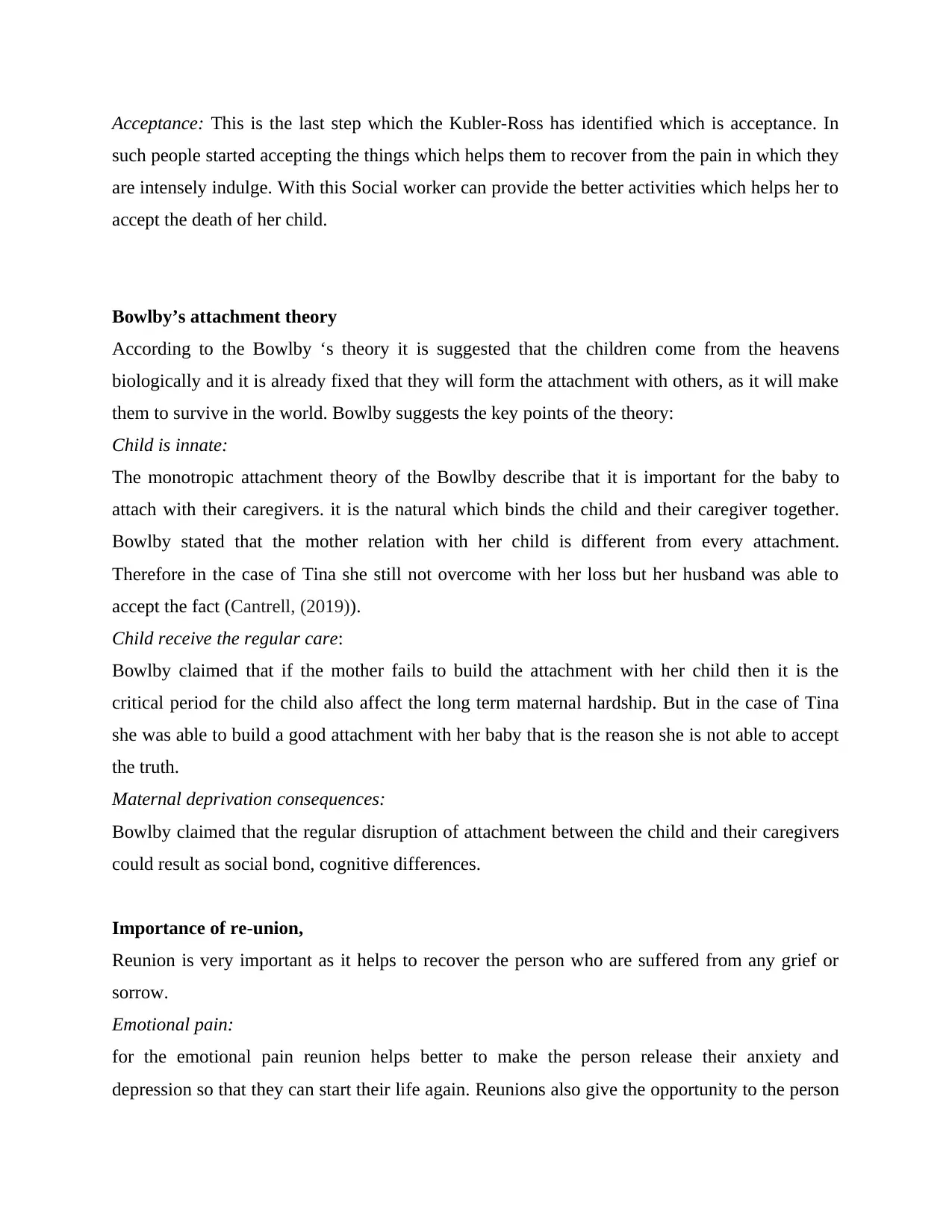
Acceptance: This is the last step which the Kubler-Ross has identified which is acceptance. In
such people started accepting the things which helps them to recover from the pain in which they
are intensely indulge. With this Social worker can provide the better activities which helps her to
accept the death of her child.
Bowlby’s attachment theory
According to the Bowlby ‘s theory it is suggested that the children come from the heavens
biologically and it is already fixed that they will form the attachment with others, as it will make
them to survive in the world. Bowlby suggests the key points of the theory:
Child is innate:
The monotropic attachment theory of the Bowlby describe that it is important for the baby to
attach with their caregivers. it is the natural which binds the child and their caregiver together.
Bowlby stated that the mother relation with her child is different from every attachment.
Therefore in the case of Tina she still not overcome with her loss but her husband was able to
accept the fact (Cantrell, (2019)).
Child receive the regular care:
Bowlby claimed that if the mother fails to build the attachment with her child then it is the
critical period for the child also affect the long term maternal hardship. But in the case of Tina
she was able to build a good attachment with her baby that is the reason she is not able to accept
the truth.
Maternal deprivation consequences:
Bowlby claimed that the regular disruption of attachment between the child and their caregivers
could result as social bond, cognitive differences.
Importance of re-union,
Reunion is very important as it helps to recover the person who are suffered from any grief or
sorrow.
Emotional pain:
for the emotional pain reunion helps better to make the person release their anxiety and
depression so that they can start their life again. Reunions also give the opportunity to the person
such people started accepting the things which helps them to recover from the pain in which they
are intensely indulge. With this Social worker can provide the better activities which helps her to
accept the death of her child.
Bowlby’s attachment theory
According to the Bowlby ‘s theory it is suggested that the children come from the heavens
biologically and it is already fixed that they will form the attachment with others, as it will make
them to survive in the world. Bowlby suggests the key points of the theory:
Child is innate:
The monotropic attachment theory of the Bowlby describe that it is important for the baby to
attach with their caregivers. it is the natural which binds the child and their caregiver together.
Bowlby stated that the mother relation with her child is different from every attachment.
Therefore in the case of Tina she still not overcome with her loss but her husband was able to
accept the fact (Cantrell, (2019)).
Child receive the regular care:
Bowlby claimed that if the mother fails to build the attachment with her child then it is the
critical period for the child also affect the long term maternal hardship. But in the case of Tina
she was able to build a good attachment with her baby that is the reason she is not able to accept
the truth.
Maternal deprivation consequences:
Bowlby claimed that the regular disruption of attachment between the child and their caregivers
could result as social bond, cognitive differences.
Importance of re-union,
Reunion is very important as it helps to recover the person who are suffered from any grief or
sorrow.
Emotional pain:
for the emotional pain reunion helps better to make the person release their anxiety and
depression so that they can start their life again. Reunions also give the opportunity to the person
You're viewing a preview
Unlock full access by subscribing today!
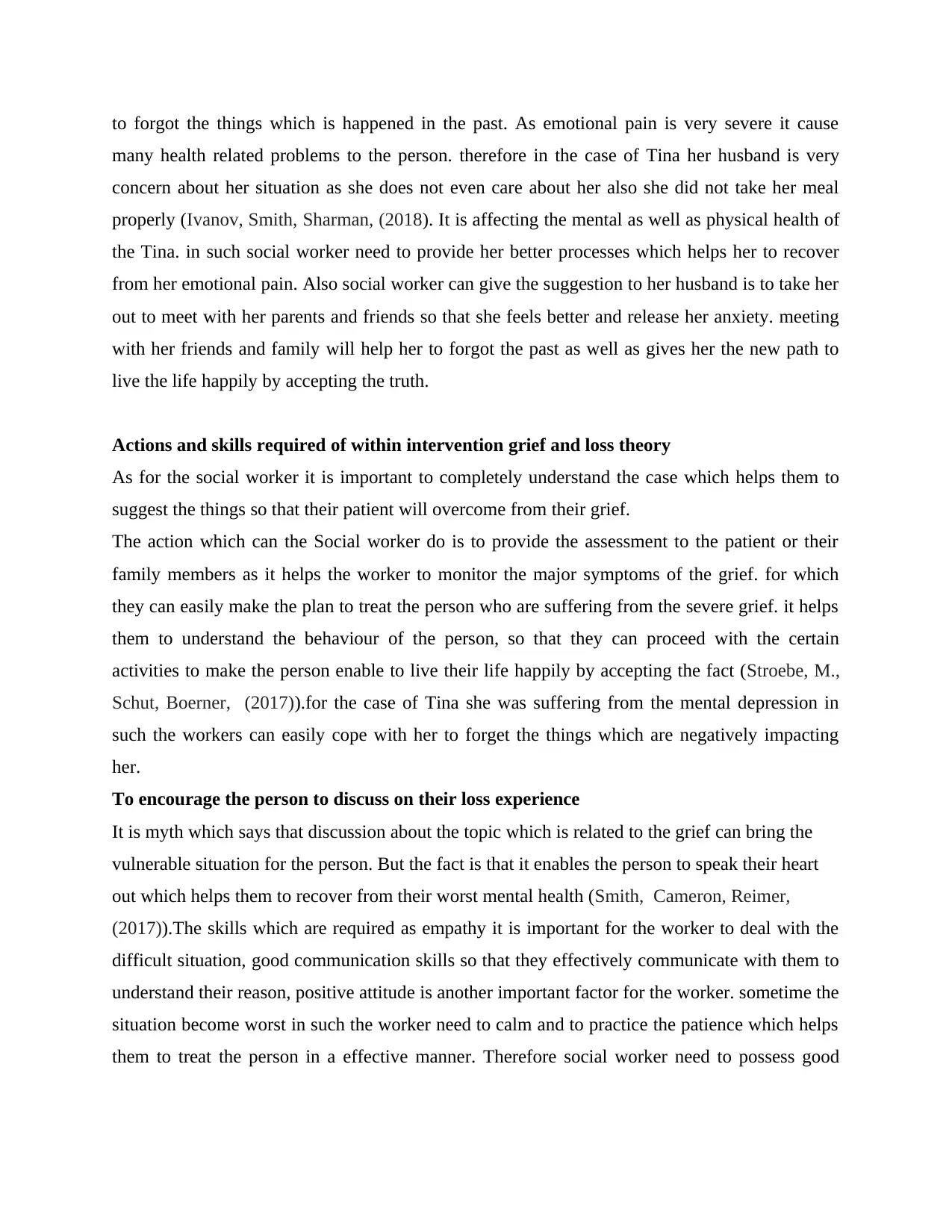
to forgot the things which is happened in the past. As emotional pain is very severe it cause
many health related problems to the person. therefore in the case of Tina her husband is very
concern about her situation as she does not even care about her also she did not take her meal
properly (Ivanov, Smith, Sharman, (2018). It is affecting the mental as well as physical health of
the Tina. in such social worker need to provide her better processes which helps her to recover
from her emotional pain. Also social worker can give the suggestion to her husband is to take her
out to meet with her parents and friends so that she feels better and release her anxiety. meeting
with her friends and family will help her to forgot the past as well as gives her the new path to
live the life happily by accepting the truth.
Actions and skills required of within intervention grief and loss theory
As for the social worker it is important to completely understand the case which helps them to
suggest the things so that their patient will overcome from their grief.
The action which can the Social worker do is to provide the assessment to the patient or their
family members as it helps the worker to monitor the major symptoms of the grief. for which
they can easily make the plan to treat the person who are suffering from the severe grief. it helps
them to understand the behaviour of the person, so that they can proceed with the certain
activities to make the person enable to live their life happily by accepting the fact (Stroebe, M.,
Schut, Boerner, (2017)).for the case of Tina she was suffering from the mental depression in
such the workers can easily cope with her to forget the things which are negatively impacting
her.
To encourage the person to discuss on their loss experience
It is myth which says that discussion about the topic which is related to the grief can bring the
vulnerable situation for the person. But the fact is that it enables the person to speak their heart
out which helps them to recover from their worst mental health (Smith, Cameron, Reimer,
(2017)).The skills which are required as empathy it is important for the worker to deal with the
difficult situation, good communication skills so that they effectively communicate with them to
understand their reason, positive attitude is another important factor for the worker. sometime the
situation become worst in such the worker need to calm and to practice the patience which helps
them to treat the person in a effective manner. Therefore social worker need to possess good
many health related problems to the person. therefore in the case of Tina her husband is very
concern about her situation as she does not even care about her also she did not take her meal
properly (Ivanov, Smith, Sharman, (2018). It is affecting the mental as well as physical health of
the Tina. in such social worker need to provide her better processes which helps her to recover
from her emotional pain. Also social worker can give the suggestion to her husband is to take her
out to meet with her parents and friends so that she feels better and release her anxiety. meeting
with her friends and family will help her to forgot the past as well as gives her the new path to
live the life happily by accepting the truth.
Actions and skills required of within intervention grief and loss theory
As for the social worker it is important to completely understand the case which helps them to
suggest the things so that their patient will overcome from their grief.
The action which can the Social worker do is to provide the assessment to the patient or their
family members as it helps the worker to monitor the major symptoms of the grief. for which
they can easily make the plan to treat the person who are suffering from the severe grief. it helps
them to understand the behaviour of the person, so that they can proceed with the certain
activities to make the person enable to live their life happily by accepting the fact (Stroebe, M.,
Schut, Boerner, (2017)).for the case of Tina she was suffering from the mental depression in
such the workers can easily cope with her to forget the things which are negatively impacting
her.
To encourage the person to discuss on their loss experience
It is myth which says that discussion about the topic which is related to the grief can bring the
vulnerable situation for the person. But the fact is that it enables the person to speak their heart
out which helps them to recover from their worst mental health (Smith, Cameron, Reimer,
(2017)).The skills which are required as empathy it is important for the worker to deal with the
difficult situation, good communication skills so that they effectively communicate with them to
understand their reason, positive attitude is another important factor for the worker. sometime the
situation become worst in such the worker need to calm and to practice the patience which helps
them to treat the person in a effective manner. Therefore social worker need to possess good
Paraphrase This Document
Need a fresh take? Get an instant paraphrase of this document with our AI Paraphraser
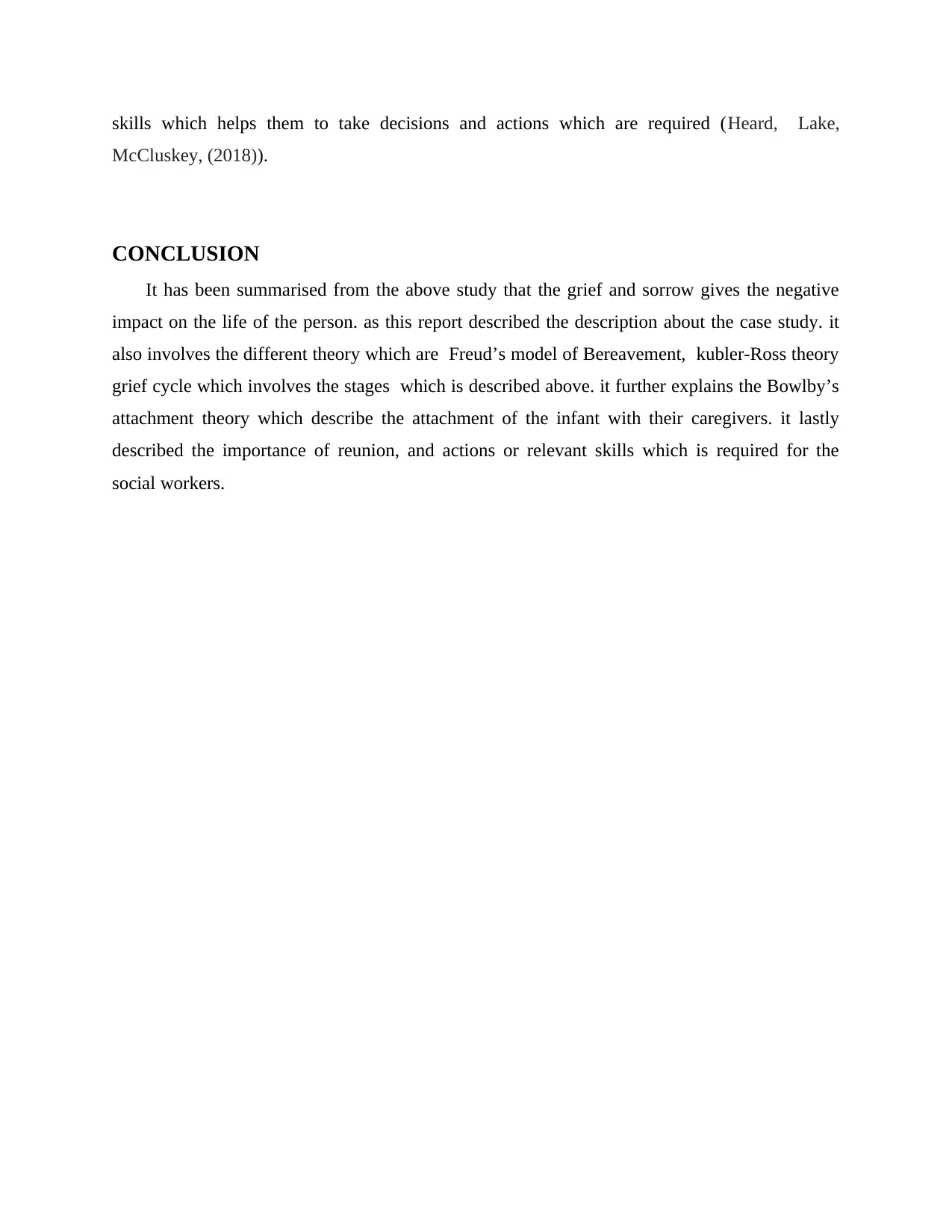
skills which helps them to take decisions and actions which are required (Heard, Lake,
McCluskey, (2018)).
CONCLUSION
It has been summarised from the above study that the grief and sorrow gives the negative
impact on the life of the person. as this report described the description about the case study. it
also involves the different theory which are Freud’s model of Bereavement, kubler-Ross theory
grief cycle which involves the stages which is described above. it further explains the Bowlby’s
attachment theory which describe the attachment of the infant with their caregivers. it lastly
described the importance of reunion, and actions or relevant skills which is required for the
social workers.
McCluskey, (2018)).
CONCLUSION
It has been summarised from the above study that the grief and sorrow gives the negative
impact on the life of the person. as this report described the description about the case study. it
also involves the different theory which are Freud’s model of Bereavement, kubler-Ross theory
grief cycle which involves the stages which is described above. it further explains the Bowlby’s
attachment theory which describe the attachment of the infant with their caregivers. it lastly
described the importance of reunion, and actions or relevant skills which is required for the
social workers.
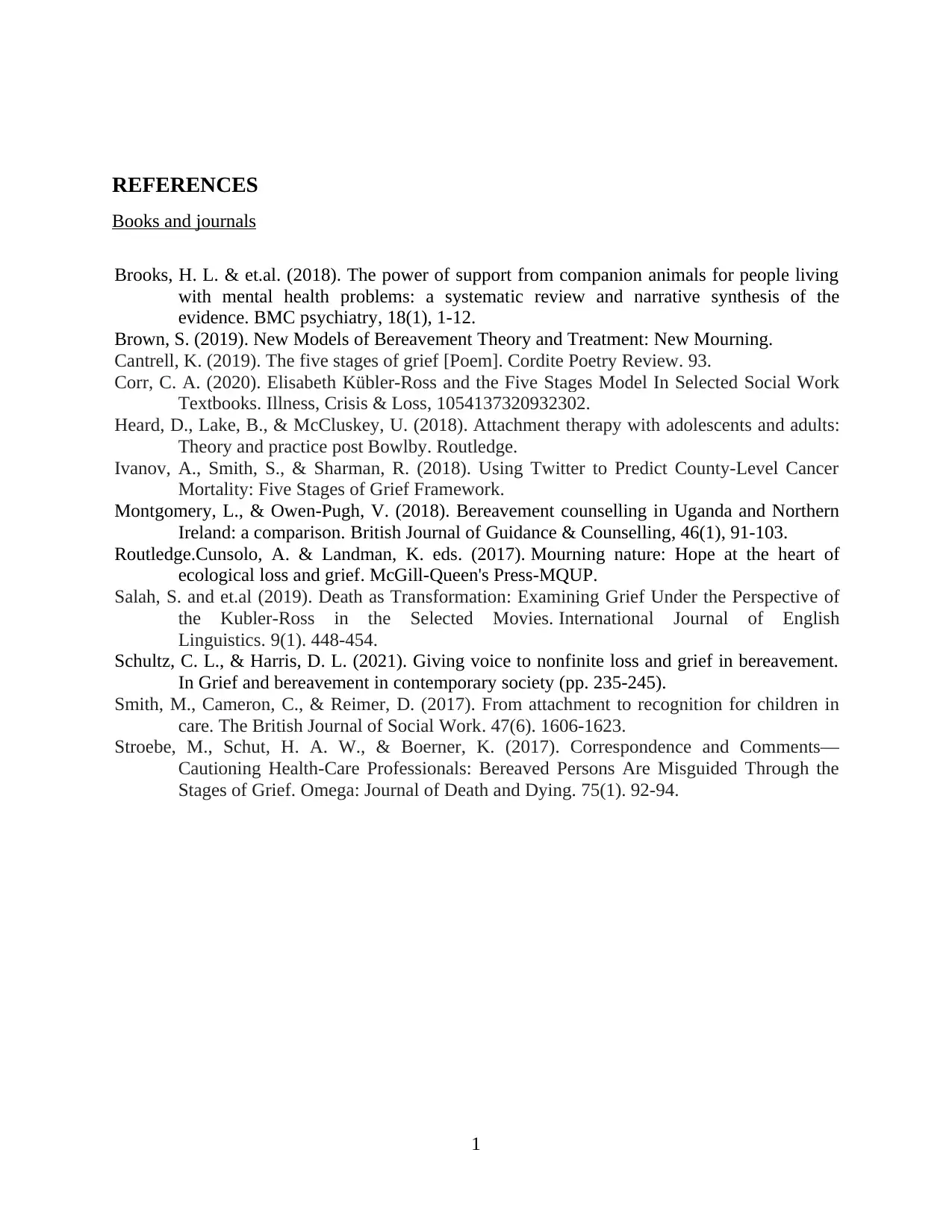
REFERENCES
Books and journals
Brooks, H. L. & et.al. (2018). The power of support from companion animals for people living
with mental health problems: a systematic review and narrative synthesis of the
evidence. BMC psychiatry, 18(1), 1-12.
Brown, S. (2019). New Models of Bereavement Theory and Treatment: New Mourning.
Cantrell, K. (2019). The five stages of grief [Poem]. Cordite Poetry Review. 93.
Corr, C. A. (2020). Elisabeth Kübler-Ross and the Five Stages Model In Selected Social Work
Textbooks. Illness, Crisis & Loss, 1054137320932302.
Heard, D., Lake, B., & McCluskey, U. (2018). Attachment therapy with adolescents and adults:
Theory and practice post Bowlby. Routledge.
Ivanov, A., Smith, S., & Sharman, R. (2018). Using Twitter to Predict County-Level Cancer
Mortality: Five Stages of Grief Framework.
Montgomery, L., & Owen-Pugh, V. (2018). Bereavement counselling in Uganda and Northern
Ireland: a comparison. British Journal of Guidance & Counselling, 46(1), 91-103.
Routledge.Cunsolo, A. & Landman, K. eds. (2017). Mourning nature: Hope at the heart of
ecological loss and grief. McGill-Queen's Press-MQUP.
Salah, S. and et.al (2019). Death as Transformation: Examining Grief Under the Perspective of
the Kubler-Ross in the Selected Movies. International Journal of English
Linguistics. 9(1). 448-454.
Schultz, C. L., & Harris, D. L. (2021). Giving voice to nonfinite loss and grief in bereavement.
In Grief and bereavement in contemporary society (pp. 235-245).
Smith, M., Cameron, C., & Reimer, D. (2017). From attachment to recognition for children in
care. The British Journal of Social Work. 47(6). 1606-1623.
Stroebe, M., Schut, H. A. W., & Boerner, K. (2017). Correspondence and Comments—
Cautioning Health-Care Professionals: Bereaved Persons Are Misguided Through the
Stages of Grief. Omega: Journal of Death and Dying. 75(1). 92-94.
1
Books and journals
Brooks, H. L. & et.al. (2018). The power of support from companion animals for people living
with mental health problems: a systematic review and narrative synthesis of the
evidence. BMC psychiatry, 18(1), 1-12.
Brown, S. (2019). New Models of Bereavement Theory and Treatment: New Mourning.
Cantrell, K. (2019). The five stages of grief [Poem]. Cordite Poetry Review. 93.
Corr, C. A. (2020). Elisabeth Kübler-Ross and the Five Stages Model In Selected Social Work
Textbooks. Illness, Crisis & Loss, 1054137320932302.
Heard, D., Lake, B., & McCluskey, U. (2018). Attachment therapy with adolescents and adults:
Theory and practice post Bowlby. Routledge.
Ivanov, A., Smith, S., & Sharman, R. (2018). Using Twitter to Predict County-Level Cancer
Mortality: Five Stages of Grief Framework.
Montgomery, L., & Owen-Pugh, V. (2018). Bereavement counselling in Uganda and Northern
Ireland: a comparison. British Journal of Guidance & Counselling, 46(1), 91-103.
Routledge.Cunsolo, A. & Landman, K. eds. (2017). Mourning nature: Hope at the heart of
ecological loss and grief. McGill-Queen's Press-MQUP.
Salah, S. and et.al (2019). Death as Transformation: Examining Grief Under the Perspective of
the Kubler-Ross in the Selected Movies. International Journal of English
Linguistics. 9(1). 448-454.
Schultz, C. L., & Harris, D. L. (2021). Giving voice to nonfinite loss and grief in bereavement.
In Grief and bereavement in contemporary society (pp. 235-245).
Smith, M., Cameron, C., & Reimer, D. (2017). From attachment to recognition for children in
care. The British Journal of Social Work. 47(6). 1606-1623.
Stroebe, M., Schut, H. A. W., & Boerner, K. (2017). Correspondence and Comments—
Cautioning Health-Care Professionals: Bereaved Persons Are Misguided Through the
Stages of Grief. Omega: Journal of Death and Dying. 75(1). 92-94.
1
You're viewing a preview
Unlock full access by subscribing today!
1 out of 9
Related Documents
Your All-in-One AI-Powered Toolkit for Academic Success.
+13062052269
info@desklib.com
Available 24*7 on WhatsApp / Email
![[object Object]](/_next/static/media/star-bottom.7253800d.svg)
Unlock your academic potential
© 2024 | Zucol Services PVT LTD | All rights reserved.





